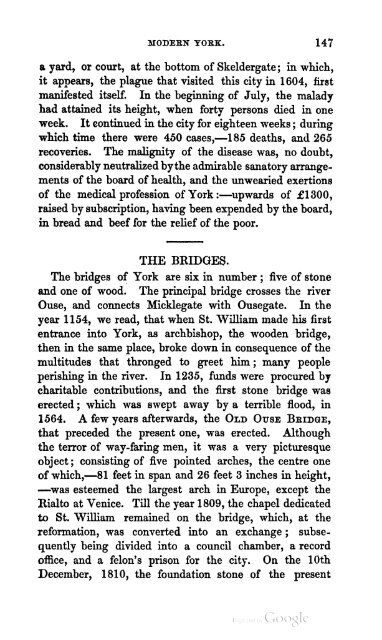Ancient_and_modern_York_a_guide
Create successful ePaper yourself
Turn your PDF publications into a flip-book with our unique Google optimized e-Paper software.
MODERN TOEK. 147<br />
a yard, or court, at the bottom of Skeldergate ; in which,<br />
it appears, the plague that visited this city in 1604, first<br />
manifested itself. In the beginning of July, the malady<br />
had attained its height, when forty persons died in one<br />
week. It continued in the city for eighteen weeks ; during<br />
which time there were 450 cases,—185 deaths, <strong>and</strong> 265<br />
recoveries. The malignity of the disease was, no doubt,<br />
considerably neutralized by the admirable sanatory arrange<br />
ments of the board of health, <strong>and</strong> the unwearied exertions<br />
of the medical profession of <strong>York</strong>:—upwards of £1300,<br />
raised by subscription, having been expended by the board,<br />
in bread <strong>and</strong> beef for the relief of the poor.<br />
THE BRIDGES.<br />
The bridges of <strong>York</strong> are six in number ; five of stone<br />
<strong>and</strong> one of wood. The principal bridge crosses the river<br />
Ouse, <strong>and</strong> connects Micklegate with Ousegate. In the<br />
year 1154, we read, that when St. William made his first<br />
entrance into <strong>York</strong>, as archbishop, the wooden bridge,<br />
then in the same place, broke down in consequence of the<br />
multitudes that thronged to greet him ; many people<br />
perishing in the river. In 1235, funds were procured by<br />
charitable contributions, <strong>and</strong> the first stone bridge was<br />
erected ; which was swept away by a terrible flood, in<br />
1564. A few years afterwards, the Old Ouse Bbidge,<br />
that preceded the present one, was erected. Although<br />
the terror of way-faring men, it was a very picturesque<br />
object ; consisting of five pointed arches, the centre one<br />
of which,—81 feet in span <strong>and</strong> 26 feet 3 inches in height,<br />
—was esteemed the largest arch in Europe, except the<br />
Rialto at Venice. Till the year 1809, the chapel dedicated<br />
to St. William remained on the bridge, which, at the<br />
reformation, was converted into an exchange ; subse<br />
quently being divided into a council chamber, a record<br />
office, <strong>and</strong> a felon's prison for the city. On the 10th<br />
December, 1810, the foundation stone of the present















